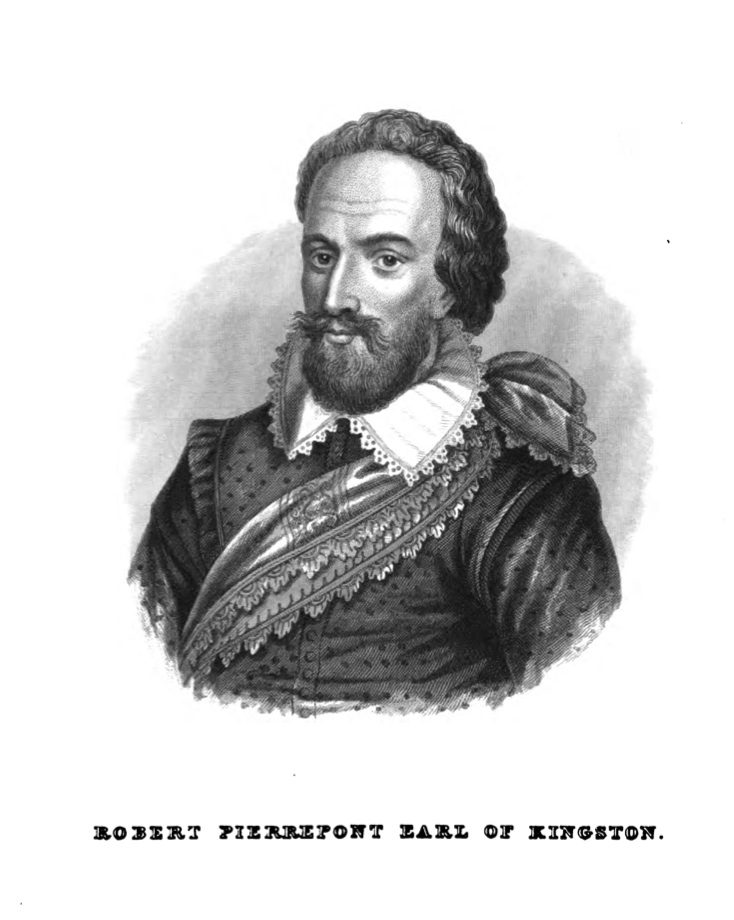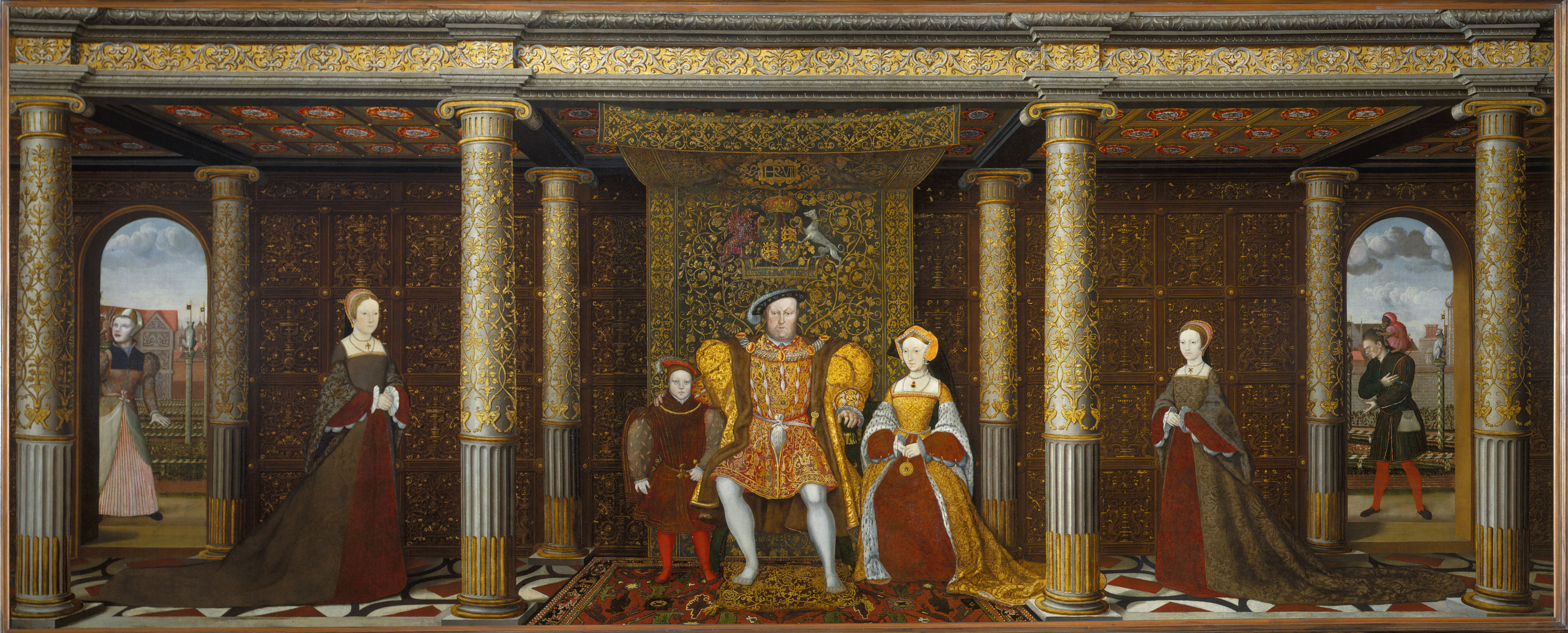|
Elizabeth Talbot, Countess Of Shrewsbury
Elizabeth Cavendish, later Elizabeth Talbot, Countess of Shrewsbury ( Hardwick; c. 1527 13 February 1608), known as Bess of Hardwick, of Hardwick Hall, Derbyshire, was a notable figure of Elizabethan English society. By a series of well-made marriages, she rose to the highest levels of English nobility and became enormously wealthy. Bess was reportedly a shrewd businesswoman, increasing her assets with business interests including mines and glass-making workshops. She was married four times. Her first husband was Robert Barley (or Barlow), who died aged about 14 or 15 on 24 December 1544. Her second husband was the courtier Sir William Cavendish. Her third husband was Sir William St Loe. Her last husband was George Talbot, 6th Earl of Shrewsbury, sometime keeper to the captive Mary, Queen of Scots. An accomplished needlewoman, Bess joined her husband's captive charge at Chatsworth House for extended periods in 1569, 1570, and 1571, during which time they worked together on ... [...More Info...] [...Related Items...] OR: [Wikipedia] [Google] [Baidu] |
Elizabeth Talbot, Countess Of Shrewsbury From NPG
Elizabeth or Elisabeth may refer to: People * Elizabeth (given name), a female given name (including people with that name) * Elizabeth (biblical figure), mother of John the Baptist Ships * HMS Elizabeth, HMS ''Elizabeth'', several ships * Elisabeth (schooner), ''Elisabeth'' (schooner), several ships * Elizabeth (freighter), ''Elizabeth'' (freighter), an American freighter that was wrecked off New York harbor in 1850; see Places Australia * City of Elizabeth ** Elizabeth, South Australia * Elizabeth Reef, a coral reef in the Tasman Sea United States * Elizabeth, Arkansas * Elizabeth, Colorado * Elizabeth, Georgia * Elizabeth, Illinois * Elizabeth, Indiana * Hopkinsville, Kentucky, originally known as Elizabeth * Elizabeth, Louisiana * Elizabeth Islands, Massachusetts * Elizabeth, Minnesota * Elizabeth, New Jersey, largest city with the name in the U.S. * Elizabeth City, North Carolina * Elizabeth (Charlotte neighborhood), North Carolina * Elizabeth, Pennsylvania * Elizabeth Tow ... [...More Info...] [...Related Items...] OR: [Wikipedia] [Google] [Baidu] |
Mary S
Mary may refer to: People * Mary (name), a feminine given name (includes a list of people with the name) Religious contexts * New Testament people named Mary, overview article linking to many of those below * Mary, mother of Jesus, also called the Blessed Virgin Mary * Mary Magdalene, devoted follower of Jesus * Mary of Bethany, follower of Jesus, considered by Western medieval tradition to be the same person as Mary Magdalene * Mary, mother of James * Mary of Clopas, follower of Jesus * Mary, mother of John Mark * Mary of Egypt, patron saint of penitents * Mary of Rome, a New Testament woman * Mary, mother of Zechariah and sister of Moses and Aaron; mostly known by the Hebrew name: Miriam * Mary the Jewess one of the reputed founders of alchemy, referred to by Zosimus. * Mary 2.0, Roman Catholic women's movement * Maryam (surah) "Mary", 19th surah (chapter) of the Qur'an Royalty * Mary, Countess of Blois (1200–1241), daughter of Walter of Avesnes and Margaret of Blo ... [...More Info...] [...Related Items...] OR: [Wikipedia] [Google] [Baidu] |
Henry Pierrepont, 1st Marquess Of Dorchester
Henry Pierrepont, 1st Marquess of Dorchester, PC, FRSFRCP(March 16068 December 1680) was an English peer. He was the son of Robert Pierrepont, 1st Earl of Kingston-upon-Hull, and his wife, the former Gertrude Talbot, daughter of George Talbot and Elizabeth Reyner, and cousin of the Earl of Shrewsbury. Career Styled Viscount Newark from 1628, he was member of parliament for Nottingham from 1628 until 1629, and was summoned to the House of Lords in his father's Barony of Pierrepont in 1641. He succeeded his father as 2nd Earl of Kingston-upon-Hull in 1643. During the earlier part of the English Civil War he was at Oxford in attendance upon the King, whom he represented at the negotiations at Uxbridge. In 1645 he was made a Privy Counsellor and created Marquess of Dorchester; but in 1647 he compounded for his estates by paying a large fine to the parliamentarians. Afterwards, Lord Dorchester, who was always fond of books, spent his time mainly in London engaged in the study ... [...More Info...] [...Related Items...] OR: [Wikipedia] [Google] [Baidu] |
Robert Pierrepont, 1st Earl Of Kingston-upon-Hull
Robert Pierrepont, 1st Earl of Kingston-upon-Hull (6 August 158425 July 1643) was an English nobleman who joined the Royalist side in the English Civil War after some delay and became lieutenant-general of the counties of Lincoln, Rutland, Huntingdon, Cambridge and Norfolk. He was killed in a friendly fire incident after being captured by Parliamentary forces. Family He was the second son of Sir Henry Pierrepont of Holme Pierrepont, Nottinghamshire, and Frances Cavendish, ThePeerage.com, Retrieved 27 December 2008 daughter of the Rt. Hon. Sir William Cavendish and Elizabeth Hardwick. His sister became |
Henry Pierrepont (MP)
Sir Henry Pierrepont (1546 – 19 March 1615) was an English MP who resided at Holme Pierrepont, Nottinghamshire. Family He was the son of Sir George Pierrepont and succeeded him in 1564. His mother, Winnifred née Twaits, remarried Sir Gervase Clifton. He married Frances Cavendish, daughter of the Rt. Hon. Sir William Cavendish and Elizabeth Hardwick. The children were: * Grace Pierrepont ThePeerage.com, accessed 27 December 2008 * * Elizabeth Pierrepont, who was brought up in the ... [...More Info...] [...Related Items...] OR: [Wikipedia] [Google] [Baidu] |
Court Of Augmentations
Thomas Cromwell established the Court of Augmentations, also called Augmentation Court or simply The Augmentation in 1536, during the reign of King Henry VIII of England. It operated alongside three lesser courts (those of General Surveyors (1540-1547), First Fruits and Tenths (1540-1554), and Wards and Liveries (1540-1660)) following the dissolution of the monasteries (1536 onwards). The Court's primary function was to gain better control over the land and finances formerly held by the Roman Catholic Church in the Kingdom of England. The Court of Augmentations was incorporated into the Exchequer in 1554 as the Augmentation Office. History and structure The Court of Augmentations was one of a number of financial courts established during Henry's reign. It was founded in 1536 to administer monastic properties and revenues confiscated by the crown at the dissolution of the monasteries. The court had its own chancellor, treasurer, lawyers, receivers and auditors. In 1547, the Co ... [...More Info...] [...Related Items...] OR: [Wikipedia] [Google] [Baidu] |
Grey Family
The House of Grey is an ancient English noble family from Creully in Normandy. The founder of the House of Grey was Anchetil de Greye, a Norman chevalier and vassal of William FitzOsbern, 1st Earl of Hereford, one of the few proven companions of William the Conqueror known to have fought at the Battle of Hastings in 1066. The Greys were first ennobled in the 13th century as Barons Grey of Codnor, of Ruthyn and of Wilton, and they were later elevated as viscounts, earls, marquesses, dukes; among them, Prime Minister Charles Grey, 2nd Earl Grey abolished slavery in the British Empire in 1833. King Edward VI declared his cousin Lady Jane Grey "the Nine Days' Queen" to be his successor as Queen of England and Ireland, and she reigned from 10 July through 19 July 1553 by her right as the great-granddaughter of King Henry VII via her parents Henry Grey, 1st Duke of Suffolk and Mary Tudor, Queen of France, until she was deposed by her cousin Mary I of England. Grey lineage 11th cent ... [...More Info...] [...Related Items...] OR: [Wikipedia] [Google] [Baidu] |
Cavendish Arms
Cavendish may refer to: People * The House of Cavendish, a British aristocratic family * Margaret Cavendish (1623–1673), British poet, philosopher, and scientist * Cavendish (author) (1831–1899), pen name of Henry Jones, English author on card games and tennis * Henry Cavendish (1731–1810), British natural philosopher and scientist * Mark Cavendish (born 1985), Manx professional road and track cyclist * Diana Cavendish from Little Witch Academia * Thomas Cavendish (1560-1592), English sailor who circumnavigated (1586-1588). Places Australia * County of Cavendish, Queensland * Cavendish Road, Brisbane, Queensland * Cavendish, Victoria Bermuda * Cavendish Tribe, original name of Devonshire Parish, Bermuda Canada * Cavendish, Alberta * Cavendish, Newfoundland and Labrador * Cavendish, a former township, subsequently merged and renamed to form Trent Lakes, Ontario * Cavendish, Prince Edward Island * Cavendish Beach, Prince Edward Island England * Cavendish, Suffolk ... [...More Info...] [...Related Items...] OR: [Wikipedia] [Google] [Baidu] |
Jane Seymour
Jane Seymour (c. 150824 October 1537) was List of English consorts, Queen of England as the third wife of King Henry VIII of England from their Wives of Henry VIII, marriage on 30 May 1536 until her death the next year. She became queen following the execution of Henry's second wife, Anne Boleyn. She died of postnatal complications less than two weeks after the birth of her only child, the future King Edward VI. She was the only wife of Henry to receive a queen's funeral or to be buried beside him in St George's Chapel, Windsor Castle. Early life Jane, the daughter of John Seymour (1474–1536), Sir John Seymour and Margery Wentworth, was most likely born at Wulfhall, Wiltshire, although West Bower Manor in Somerset has also been suggested. Her birth date is not recorded; various accounts use anywhere from 1504 to 1509, but it is generally estimated around 1508. Through her maternal grandfather, she was a descendant of King Edward III's son Lionel of Antwerp, 1st Duke of Clarenc ... [...More Info...] [...Related Items...] OR: [Wikipedia] [Google] [Baidu] |
Anne Boleyn
Anne Boleyn (; 1501 or 1507 – 19 May 1536) was Queen of England from 1533 to 1536, as the second wife of King Henry VIII. The circumstances of her marriage and of her execution by beheading for treason and other charges made her a key figure in the political and religious upheaval that marked the start of the English Reformation. Anne was the daughter of Thomas Boleyn, 1st Earl of Wiltshire, and his wife, Lady Elizabeth Howard, and was educated in the Netherlands and France, largely as a maid of honour to Queen Claude of France. Anne returned to England in early 1522, to marry her Irish cousin James Butler, 9th Earl of Ormond; the marriage plans were broken off, and instead, she secured a post at court as maid of honour to Henry VIII's wife, Catherine of Aragon. Early in 1523, Anne was secretly betrothed to Henry Percy, son of Henry Percy, 5th Earl of Northumberland, but the betrothal was broken off when the Earl refused to support their engagement. Cardinal Thoma ... [...More Info...] [...Related Items...] OR: [Wikipedia] [Google] [Baidu] |
Codnor Castle
Codnor Castle is a ruined 13th-century castle in Derbyshire, England. The land around Codnor came under the jurisdiction of William Peverel after the Norman conquest. The building is registered as a Scheduled Ancient Monument a Grade II Listed Building and is officially a Building at Risk. History William Peverel The castle is a stone keep and bailey fortress, and was established by William Peverel. The present fragmentary remains represent a three-storey keep and a strong curtain wall and ditch, flanked by round towers. The outer bailey is on a lower level, and was constructed at a later period. The castle overlooks the Erewash valley and the counties of Derbyshire and Nottinghamshire. It originally had a deep moat, and on its eastern side, there was once a considerable abundance of trees, which have now been cut down. On the west side, there was a courtyard that was strongly fortified by huge round towers, which had battlements. In other parts of the ruins, there is evidence t ... [...More Info...] [...Related Items...] OR: [Wikipedia] [Google] [Baidu] |




.png)
